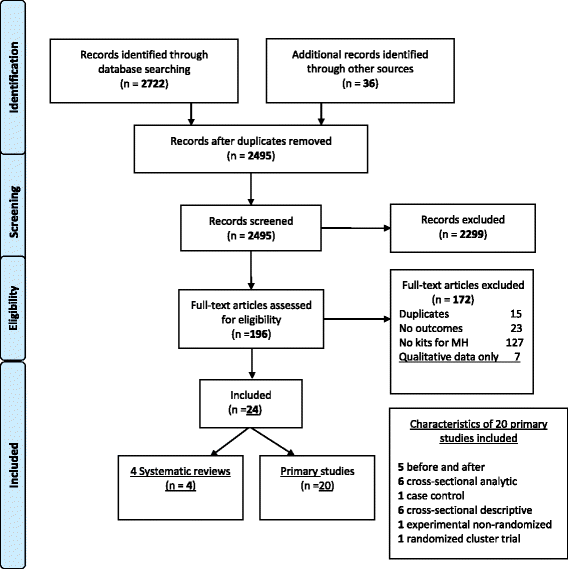Supply kits for antenatal and childbirth care: a systematic review
- PMID: 29237472
- PMCID: PMC5729253
- DOI: 10.1186/s12978-017-0436-9
Supply kits for antenatal and childbirth care: a systematic review
Abstract
Introduction: It is critical to increase the uptake of interventions proven to be effective to improve maternal and perinatal outcomes. Supply kits have been suggested to be a feasible strategy designed to ensure timely availability and effective follow-up of care.
Objective: We conducted a systematic review to summarize the evidence on the uptake, effectiveness and safety of supply kits for maternal care.
Search strategy: MEDLINE, the Cochrane Pregnancy and Childbirth Group's Trials Register, Campbell Collaboration, Lilacs, Embase and unpublished studies were searched.
Selection criteria: Studies that reported the efficacy, safety and use of supply kits for maternal healthcare were eligible. Participants were pregnant women or in childbirth. Supply kits were defined as a collection of medicines, supplies or instruments packaged together with the aim of conducting a healthcare task.
Data collection and analysis: Two reviewers independently performed the screening, data extraction, and methodological and quality assessment.
Main results: 24 studies were included: 4 of them were systematic reviews and 20 primary studies. Eighteen studies evaluated a so-called "clean delivery kit". In all but two studies, the kits were used by more than half of the participants. A meta-analysis was deemed inappropriate due to the heterogeneity in study design, in the components of the interventions implemented, in the content of the kits, and in outcomes. Nine studies assessed neonatal outcomes and found statistically significant reductions in cord infection, sepsis and tetanus-related mortality in the intervention group. Three studies showed evidence of reduced neonatal mortality (OR 0.52, 0.60 and 0.71) with statistically significant confidence intervals in all cases. Four studies reported odd ratios for maternal mortality, but only one showed evidence of a statistically significant decrease in this outcome but it was ascribed to hand washing prior to childbirth and not with the use of kits.
Conclusion: This review suggests potential benefits in the use of supply kits to improve maternal and neonatal health. However, the observational nature of the studies, the heterogeneity and the use of kits incorporated within complex interventions limit the interpretation of the findings.
Keywords: Childbirth; Clean delivery kits; Maternal mortality; Neonatal mortality; Pregnancy; Supply kits.
Conflict of interest statement
Ethics approval and consent to participate
Not applicable.
Consent for publication
All authors consent publication.
Competing interests
The authors declare that they have no competing interests.
Publisher’s Note
Springer Nature remains neutral with regard to jurisdictional claims in published maps and institutional affiliations.
References
-
- World Health Organization (WHO). Maternal Mortality. Fact sheet N° 348. Updated November 2015. http://www.who.int/mediacentre/factsheets/fs348/en/. Accessed 26 Oct 2016.
-
- United Nations. Open working group of the general assembly on sustainable development goals. 2014. http://undocs.org/A/68/970. Accessed 30 July 2016.
-
- Institute of Medicine (US) Committee on Improving Birth Outcomes; Bale JR, Stoll BJ, Lucas AO, editors. Improving Birth Outcomes: Meeting the Challenge in the Developing World. Washington (DC): National Academies Press (US); 2003. Available from: https://www.ncbi.nlm.nih.gov/books/NBK222097/. doi:10.17226/10841. - PubMed
Publication types
MeSH terms
Grants and funding
LinkOut - more resources
Full Text Sources
Other Literature Sources
Medical


